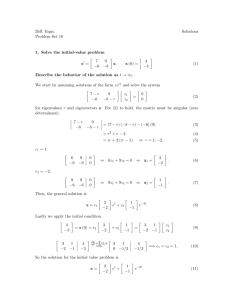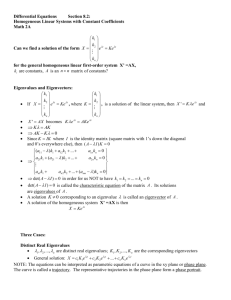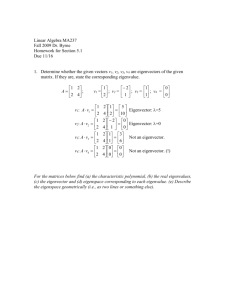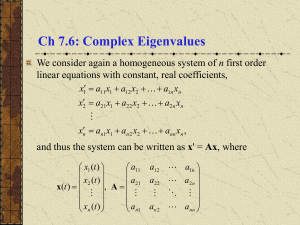This section is written to give you a written reference on complex
advertisement
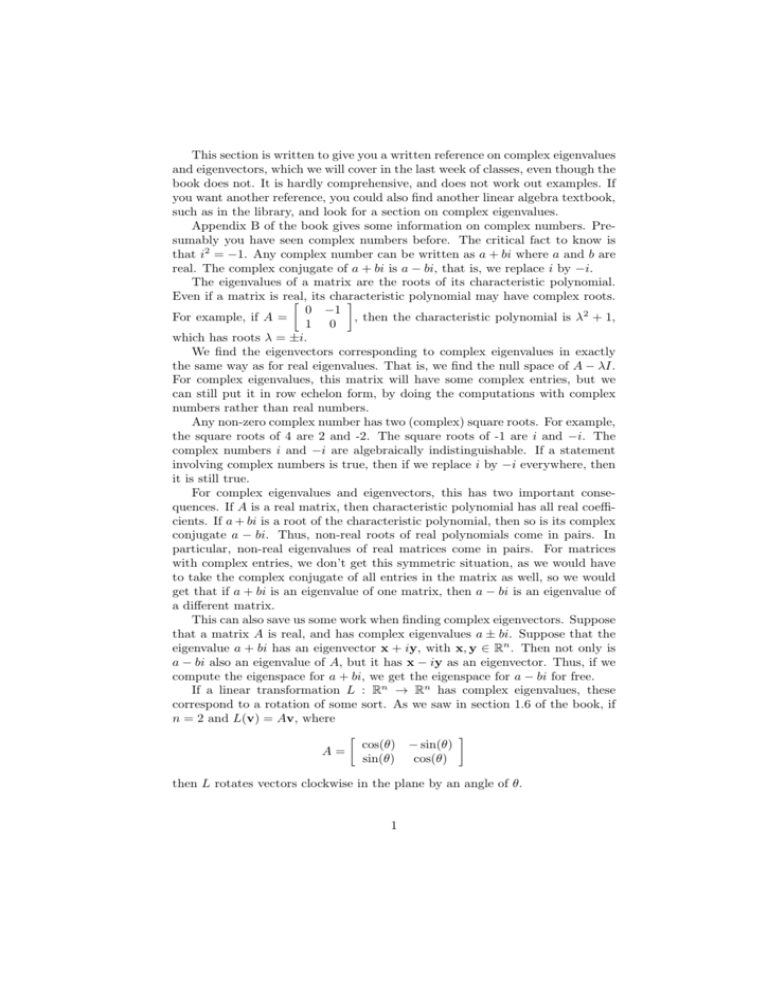
This section is written to give you a written reference on complex eigenvalues and eigenvectors, which we will cover in the last week of classes, even though the book does not. It is hardly comprehensive, and does not work out examples. If you want another reference, you could also find another linear algebra textbook, such as in the library, and look for a section on complex eigenvalues. Appendix B of the book gives some information on complex numbers. Presumably you have seen complex numbers before. The critical fact to know is that i2 = −1. Any complex number can be written as a + bi where a and b are real. The complex conjugate of a + bi is a − bi, that is, we replace i by −i. The eigenvalues of a matrix are the roots of its characteristic polynomial. Even if a matrix is real, polynomial may have complex roots. its characteristic 0 −1 For example, if A = , then the characteristic polynomial is λ2 + 1, 1 0 which has roots λ = ±i. We find the eigenvectors corresponding to complex eigenvalues in exactly the same way as for real eigenvalues. That is, we find the null space of A − λI. For complex eigenvalues, this matrix will have some complex entries, but we can still put it in row echelon form, by doing the computations with complex numbers rather than real numbers. Any non-zero complex number has two (complex) square roots. For example, the square roots of 4 are 2 and -2. The square roots of -1 are i and −i. The complex numbers i and −i are algebraically indistinguishable. If a statement involving complex numbers is true, then if we replace i by −i everywhere, then it is still true. For complex eigenvalues and eigenvectors, this has two important consequences. If A is a real matrix, then characteristic polynomial has all real coefficients. If a + bi is a root of the characteristic polynomial, then so is its complex conjugate a − bi. Thus, non-real roots of real polynomials come in pairs. In particular, non-real eigenvalues of real matrices come in pairs. For matrices with complex entries, we don’t get this symmetric situation, as we would have to take the complex conjugate of all entries in the matrix as well, so we would get that if a + bi is an eigenvalue of one matrix, then a − bi is an eigenvalue of a different matrix. This can also save us some work when finding complex eigenvectors. Suppose that a matrix A is real, and has complex eigenvalues a ± bi. Suppose that the eigenvalue a + bi has an eigenvector x + iy, with x, y ∈ Rn . Then not only is a − bi also an eigenvalue of A, but it has x − iy as an eigenvector. Thus, if we compute the eigenspace for a + bi, we get the eigenspace for a − bi for free. If a linear transformation L : Rn → Rn has complex eigenvalues, these correspond to a rotation of some sort. As we saw in section 1.6 of the book, if n = 2 and L(v) = Av, where cos(θ) − sin(θ) A= sin(θ) cos(θ) then L rotates vectors clockwise in the plane by an angle of θ. 1 More generally, if c ∈ R and c cos(θ) −c sin(θ) A= c sin(θ) c cos(θ) then L(v) = Av rotates a vector clockwise by θ, and also multiplies its length by c. We can compute that the characteristic polynomial of A is λ2 −2cλ cos(θ)+c2 , which has roots λ = c cos(θ) ± ic sin(θ). If a 2 × 2 matrix has roots a ± bi, we can set this equal to c cos(θ) ± ic sin(θ) √ and get c = a2 + b2 and tan(θ) = ab . This is basically converting between rectangular and polar coordinates, and the usual complications about distinguishing between θ and θ + π apply. Converting direction gives us in the other a −b a = c cos(θ), b = c sin(θ), so the matrix is A = . b a Any A with complex eigenvalues is similar to a matrix of the 2 × 2 matrix a −b form . If the eigenvalue a + bi has eigenvector x + iy, then the b a similarity is via a matrix P whose columns are x and −y, and we get a −b A=P P −1 . b a For larger matrices with complex eigenvalues, the situation is more complicated. We still get a rotation of some sort, but the axis about which we rotate is less obvious. If A is a 2 × 2 rotation matrix, then this tells us pretty directly what An does geometrically. If A rotates by some angle, then An rotates by n times as big of an an angle. If A rotates by some angle and scales vectors by c, then An rotates by n times as big of an angle and scales by cn . 2
